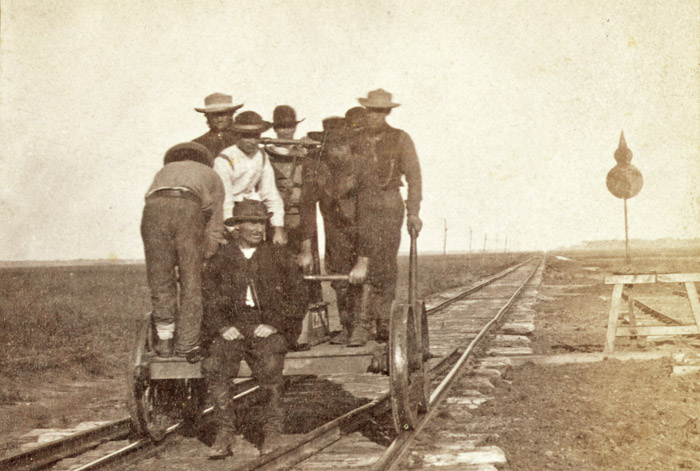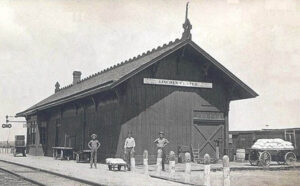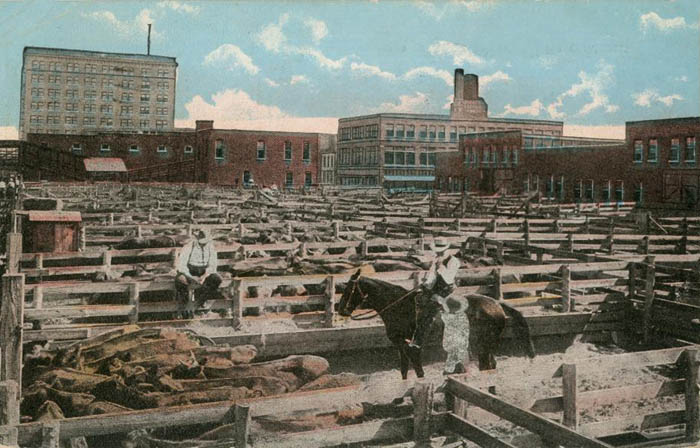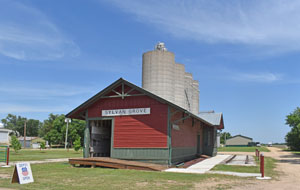
Section Men near Salina, Kansas, by Alexander Gardner.
The Salina, Lincoln, and Western Railroad was a three-foot standard gauge line built westward from Salina, Kansas, through Lincoln, Kansas.
Construction was planned to begin in October 1871 on the Kansas Central Railway, a three-foot gauge line built westward from Leavenworth ultimately to Miltonvale. The original plans were to build the line westward to Colorado, reaching Lincoln, Kansas, by 1880.
However, the railroad line was delayed, and construction did not begin until 1886, when the first section of a 108-mile-long track was built, running northwestward from Salina to five miles west of Plainville.
The railroad line was originally created to service large Kansas farming and stockyard centers in remote areas of Kansas. It shipped coal, building materials, and other merchandise out of Salina into remote Kansas areas and agricultural and livestock products out of those areas. In addition, the railroad stockholders fostered the economic development of western Kansas by encouraging people to relocate to towns along the line -– the incentive being that the cost of land in western Kansas was 1/10th of what it cost in the eastern part of the state.
The Plainville Branch was a prominent rail line in central and northwestern Kansas and important to the region’s economic development. About 15 towns were along the line, and the trains stopped in each. The Plainville Short Line traveled east in the morning to the larger town of Salina and returned in the afternoon. The morning train carried the cream cans to a creamery in Salina, while the afternoon train delivered mail from a regional post office.
At the same time, other railroad companies were quickly becoming established in western Kansas. The Oakley and Colby Railroad built a 21-mile stretch of track northwestward from Oakley to Colby in the same year the Salina, Lincoln, and Western Railroad opened.
When the Salina, Lincoln, and Western Railway came to Lincoln in the mid-1880s, it designated its station as Lincoln Center.
The Sylvan Grove Union Pacific Depot, built in 1887, is an example of a combination depot, meaning it served both freight and passenger needs. It is located at the south end of Sylvan Grove’s Main Street and is in its original location.
In 1888, the Lincoln and Colorado Railway Company connected the two lines with a 96-mile stretch of track.
Four weeks later. On November 18, 1888, the first passenger train arrived in Hill City. Plainville was established as the division point between Salina and Colby, and the three lines operated together until the 1890s. In October 1898, the Union Pacific Railroad assumed ownership of all three railroad lines, which created the United Pacific Railroad’s longest branch line. The Plainville Branch was an economic link to larger shipping centers. The cattle ranches of western Kansas depended on it. Every Saturday for decades, the”Cattlemen’s Special” train number 190 departed Colby for Salina. All along the Plainville Branch, the train picked up preloaded cattle cars and transported them via Salina to Kansas City, Missouri, for Monday morning trade. The last of the stockyards along the line were retired in 1965.
In 1889, two scheduled daily trains ran in each direction except Sundays.
In October 1898, the Union Pacific Railroad assumed ownership of all three railroad lines, which created the company’s longest branch line. The Plainville Branch was an economic link to larger shipping centers. The cattle ranches of western Kansas depended on it. Every Saturday for decades, the”Cattlemen’ss Special”” train number 190, departed Colby for Salina. All along the Plainville Branch, the train picked up preloaded cattle cars and transported them via Salina to Kansas City, Missouri, for Monday morning trade.
Due to economic issues, the schedules were reduced to one train daily in the 1890s and returned to two daily by 1902.
Automobiles eventually became a more popular travel mode and displaced passenger rail service. May 31, 1958, was the last day of passenger train service between Oakley and Salina, marking the end of an era in western Kansas.
The last of the stockyards along the line were retired in 1965.
Sylvan Grove’s depot closed in 1968, and the rails on either side of the building were removed following the 1993 flood. The wood-frame building is an example of a standardized late-19th-century combination depot with minimal ornamentation, though the eave brackets and gable-end embellishments reflect the Victorian-era Stick style. It is listed on the National Register of Historic Places as part of the”“Historic Railroad Resources of Kansa”” multiple property nomination.
In the mid-to-late 1980s, scheduled trains were eliminated, with trains running as needed to serve the grain elevators. The line was in full operation until the floods in 1993 damaged the track between Salina and Plainville. Subsequently, the Union Pacific Railroad determined that rebuilding that branch line section would not be cost-effective. The damaged section was dismantled in 1995, and the remaining line from Plainville to Colby was dismantled between 1997 and 1998.
©Kathy Alexander/Legends of Kansas, May 2024.
Also See:
Railroads & Depot Photo Gallery
Sources:
Abandoned Rails
CMS Geology Post
Live in Lincoln County
Solomon Valley Highway 24 Heritage Alliance



